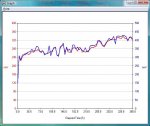ok, I got it working, i used my USB serial bus, which is basicaly serial in, usb out to computer. it works fine.
I did not install the .1uf cap on the LPM board yet.
When I click on view graph, it gives me a red and a blue line, what do they stand for?
EDIT I installed the cap, and i must say, DO NOT USE THE INTERFACE BOARD WITHOUT THE CAP ON THE LPM BOARD!! This SUBSTANTIALLY reduced noise. but it didn't eliminate it...
what do I do to calculate my own gain?
also, the readings on the Interface program are higher than the reading on my DPM. the gap increases exponentially, at 10mW on the DPM, for example, the interface shows 12-14, (doesn't stop on a single number). but at 260mW on the DPM, the interface program shows 290...
which one do I trust?
amk




